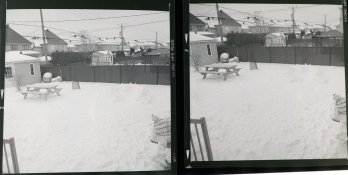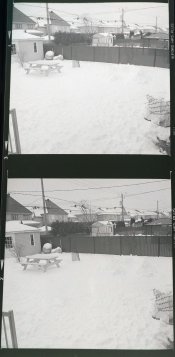Today's a pretty dull day in the Montréal region, so I went out in the backyard and shot a test roll. Here's my logic:
- In 120, I really like HP5+ in DK-50 1+1. The developer gives me sharp images with brilliant highlights, while the film maintains good shadow details.
- My normal regimen in to expose at EI 250, and develop for 5:45. I have a couple of images of this combo in my gallery.
- Today, I set my spot meter at EI 400 so that the shadows would receive less exposure.
- I am also going to develop for 7 mins, which is 20% more time than my usual 5:45.
- When I metered, I tried to place snow as high as I could (Zone VI or VII). That's one to two stops above the meter's reading when pointed at the snow. I also checked my exposure by measuring other items in the yard (fence, table, etc.)
- I bracketed exposures, and made two series: one without a filter, and one with an orange filter (3x factor).
That's about as much as I can do in-camera. In the darkroom, I should have latitude to dodge and burn specific areas to get the detail and the tones where I want them.
Another idea that popped into my mind as I wrote this, is: if possible, why not just use flash? Of course, it doesn't work for a wide expanse of landscape, but if you're shooting something at close range, adding some fill-in flash (especially if it's offset from your camera) could give you better texture detail.










